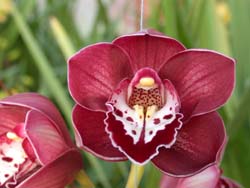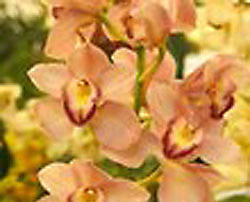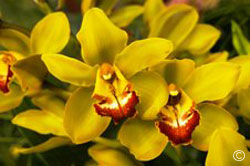 Cymbidium orchids are native to tropical Asia and Australia. Known as the hardiest of orchids, they have long yellow-green arching foliage. The blossom size and number of flowers vary by variety, ranging from an inch to five inches in diameter, and from a few flowers to more than 20 per flowering stem. In their native habitat, they are epiphytes, or they grow in trees without soil supporting their roots. All cymbidiums have short, bulbous pseudobulbs, or thickened stems, which store water and bear multiple, strap-like, arching leaves.
Cymbidium orchids are native to tropical Asia and Australia. Known as the hardiest of orchids, they have long yellow-green arching foliage. The blossom size and number of flowers vary by variety, ranging from an inch to five inches in diameter, and from a few flowers to more than 20 per flowering stem. In their native habitat, they are epiphytes, or they grow in trees without soil supporting their roots. All cymbidiums have short, bulbous pseudobulbs, or thickened stems, which store water and bear multiple, strap-like, arching leaves.
Cymbidium orchids perform best with high indoor light; they prefer direct early morning or late afternoon light. They must receive strong light to produce healthy growth and to flower well. They need a potting mix that drains well and made up of redwood bark chips, coarse charcoal or perlite, supplemented with unmilled sphagnum moss or coarse peat moss to enhance water retention.
Cymbidiums prefer temperatures in the 55-85 degrees Fahrenheit. In addition, standard cymbidiums, or the large-flowered varieties, require a six to eight week cool period in the fall when night temperatures are at least 45 to 50 degrees Fahrenheit to form buds. Modern miniature hybrids do not require such low temperatures to induce flower buds; a low temperature of 60 degrees is adequate.

Plant should be kept moist, so frequent watering may be needed. They thrive in 50 to 80 percent relative humidity. To increase humidity, place the pot on a tray filled with pebbles and water. Keep the water level in the tray below the bottom of the pot to prevent water wicking into the pot which, over time, may lead to root rot.
Fertilize these orchids frequently when new growth is forming, generally from spring through summer, with a water-soluble commercialorchid 20-20-20 fertilizer during summer and fall, cutting back to 1/3 recommended rate winter to spring.

Cymbidiums bloom only once a year and the season of bloom varies by species or hybrid. Repot these orchids every two to three years when new growth begins, generally in spring.
Mealybugs and scale insects are occasionally attracted to cymbidiums. They are also susceptible to viruses and root rot.
For “Viruses in Plants” refer to message number 1443.
For more information, see the following Planttalk Colorado™ video(s).
For more information, see the following Colorado State University Extension fact sheet(s).



